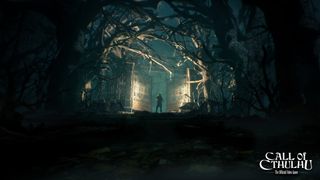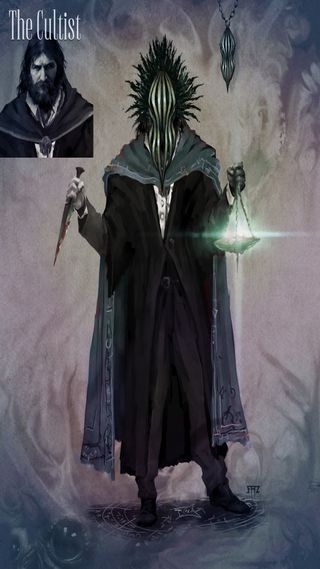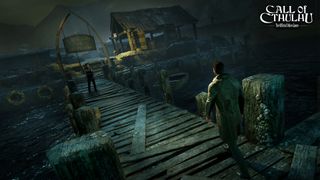Can Call of Cthulhu ever be a good videogame?
Why it's nearly impossible to truly capture Lovecraft in a videogame, and how Cyanide Studios hopes to pull it off.

The Innsmouth look: how to get that slimy Cthulhu feel
I asked Gueney about their approach to horror—generally—and he seemed to have it pretty well thought out. “We want to be faithful to Lovecraft’s way to instill horror,” he said. “The main character will see unexplainable things, experience traumatic events, although he will have reason to doubt what he encountered. To instill that in players’ minds, we’ll use specific sound and visual effects.”
They want to avoid gore, jump scares, and the like. I pointed out Lovecraft’s reliance on visceral goo, but Gueney shied away. “We don’t want to fill the game up with dozens of tentacles and slimy creatures,” he said. “We’ll use such classic horror elements with parsimony.” Gueney actually strikes against a lot of modern Cthulhu Mythos art. “We believe that some of the depictions of Lovecraft’s work can be fairly grotesque, and that is definitely something we are trying to avoid.”

Elaborating on how he would like to scare us, he gives a curious example: “Sometimes you’ll need to double take, unsure if what you saw was actually in the game, or rather in your mind. Similar to when people see a face in a cloud, or when you see Jesus in a slice of toast. When you look a little longer, you realize nothing was there… or was it? And what does it mean?”
I expect a lot of that kind of horror to be managed by your Sanity score. Sanity is a huge factor in Call of Cthulhu tabletop—losing your mind was a way to die, but it was also a way to succeed. For example, only the slightly insane could actually use the rituals that summoned or banished many alien beings. Cyanide seems to be embracing that.
Gueney outlined their thinking: “The lower your score, the deeper you’ll plunge into madness. This will be translated in-game by hallucinations and phobias for the main hero to develop. The interesting thing is that you won’t be able to avoid it completely, and sometimes taking that hit on your sanity meter will have other benefits. You’ll have to balance that.“
Anyone who has played Call can remember a moment where a monster appeared and they couldn’t yell “I look away!” fast enough, and Gueney definitely knows that. “Seeing and facing such horror often leads to death and madness,” he said. “This will be the case for the hero of our game. Even if the player will encounter memorable creatures, the impact on the main character’s mind will be significant. The players will have to resist their urges to gaze at Lovecraft’s horrors.” In Lovecraft’s Cthulhu, Cyanide understands, the monsters are not the threat you see the most of—that honor is reserved for your fellow man, the only monster you can actually overcome.
Putting the screws to Gueney on the subject of combat, I cited how rarely fighting gets you what you want in the tabletop game. He quickly agreed: “Direct confrontation will lead to an early demise.” Despite that, what he said next reminded me of the worst puzzle-like fights with “undefeatable” horrors in past Cthulhu games. “The player will have to observe environment and work out alternate solutions,” he said. “Weapons are going to be scarce, loud and mostly ineffective against monsters.”
The biggest gaming news, reviews and hardware deals
Keep up to date with the most important stories and the best deals, as picked by the PC Gamer team.
Otherwise, gameplay that’s not about sneaking around, investigating, and dodging horrors sounds intriguing. Edward Pierce will meet companions who can be sent to gather clues while he investigates locations in person. Gueney impressed on me that NPC relationships were important, despite the traditional unreliability of friends and relatives in Lovecraft’s works.
“They can be as unreliable as expected in a Lovecraftian tale,” he said, “but we prefer to rely on players’ choices when it comes to relations. The way the players manage their acquaintances is going to be pivotal during the last moments of the adventure: We have several endings, some of which are impacted by our relationship system.”
Months later, reflecting on that, I like it. Having a team of characters working (and dying) together is a major part of the tabletop game’s feel—no adaptation would be complete without it.
Seeing and facing [creatures] often leads to death and madness. Players will have to resist their urges to gaze at Lovecraft’s horrors. — Jean-Marc Gueney
But all of those gameplay solutions only addresses a handful of the pitfalls on the road to faithful Lovecraft. Lots of developers have tried, and failed, to live up to the ideals of cosmic horror—let alone taking on the legacy of Call of Cthulhu. Others have skirted the edges of it, but in the process drifting the genre into something new. That’s good! That’s how new ideas enter the space—but I’m still attached to the old way of doing things.
There are principles that will keep developers on track. A Lovecraft game is constructed very specifically. First, it establishes that the characters are fragile things—breakable and intensely human. The narrative is a slow, ever-deepening reveal. A slow burlesque where clothes just keep coming off, revealing ever-more clothes, like scarves from a magician’s sleeve. You are desperate to know more. The story suddenly forefronts an unforgiving, inhuman cosmicism. You realize that there is only an infinity of deeper layers—a vast tapestry of which you are only an insignificant part.
You go to read a book, or overhear a conversation between hooded figures, and the knowledge you receive drives you into madness. Those words, that print, that tongue, was never meant for human ears. You get a glimpse of the burlesque dancer’s skin, and it is not skin. Then, it ends. You’re left shivering, cold, and alone with your dread.

Interestingly, Gueney already had a theory of his own on how a Lovecraftian story is constructed. “Before getting to cosmic horror,” he said, “a Lovecraftian tale follows a very specific narrative pattern: mundane circumstances trigger a series of intriguing events that lead the main characters to some form of investigation. Before they realize it, they are facing the truth about reality and the fate of humanity. We’re doing our best to be as faithful as possible to this narrative structure.”
From talking with Jean-Marc Gueney, from seeing the Cyanide team at work, I think they’re on the right track. But we cannot know until we get the game and see if they’ve managed to mesh investigation, story, characters, and horror into a coherent whole. We will yet see what they unleash—for good or for ill.
“The horror will build slowly during the game until, at some point, the truth will be inevitable,” said Gueney. I think the same can be said about the waiting.
Call of Cthulhu is slated to release in 2017.
Jon Bolding is a games writer and critic with an extensive background in strategy games. When he's not on his PC, he can be found playing every tabletop game under the sun.

Palworld developer reports Nintendo's suing over 3 Pokémon patents for only $66,000 in damages, but a videogame IP lawyer says fighting the lawsuit could mean 'burning millions of dollars'

No Man's Sky gets cross-save on a dozen platforms and brings back Mass Effect's Normandy as a limited-time rewar
Most Popular


